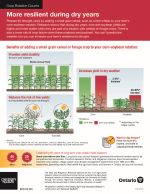
Crop rotation counts: Higher yield (PDF 250KB)
Improve yield of corn and soybean by adding a small grain cereal (e.g., winter wheat) or a forage crop to your farm’s corn-soybean rotation.
Changes in soil productivity can take years to manifest, which means on-farm trial and error for different rotations is challenging for farmers to conduct independently. That’s where long-term research comes in, to help farmers have the healthiest soil, highest yield and greatest profits.
Decades-long investigations have been conducted at the Ontario Crops Research Centres in Ridgetown and Elora. These government-owned stations have been operating long-term rotation plots (LTRPs)—fields that rotate between a number of different crops—to study improvements in commodities produced there. The overall goal for these test plots is to improve crop resilience and benefit the agri-food sector by lowering costs, increasing profits and improving soil health.
The research centres where these test plots are located are owned by the Agricultural Research and Innovation Ontario and managed by the University of Guelph through the Ontario Agri-Food Innovation Alliance. University of Guelph researchers have been measuring crop performance at the Ridgetown and Elora sites for 25 and 40 years, respectively. With 65 combined years of LTRP research data available, farmers are able to see the tangible benefits of crop rotation without the need for every farm to conduct its own trial.
Dr. Bill Deen, a professor who recently retired from the Department of Plant Agriculture, ran experiments at the Elora site from 2000 to 2020. He oversaw numerous long-term projects including a rotation trial that began in 1980, a tillage trial started in 1976 and a nitrogen in maize trial started in 2008.
“Whenever you’re looking at cropping systems’ effects, they have to be compared side by side in the same environment, otherwise you start comparing across environments and they become confounded,” he says. “That is the real value of the LTRPs—you can compare the impact of system changes within a given soil and system environment.”
The results of LTRP trials at the Elora and Ridgetown sites have shown great success in determining which rotations yield the healthiest crops and soil. This research has specifically determined that adding a small grain cereal like wheat into soybean and corn rotations is especially beneficial. Other key findings include improvements in nutrient return, drought-resilient crops, improved cover crops and increased available nitrogen in the soil. These results translate to direct cost-saving benefits for farmers who can expect increased yields of crops that are more resilient during dry seasons and require less fertilizer to grow.
“Society will benefit if agriculture strongly adopts rotation diversity,” said Deen. “A good sustainable system has to start with rotation diversity. Good rotations increase yield, and LTRPs definitely provide insights into what constitutes a resilient cropping system.”
This article originally appeared in the 2021 Agri-Food Yearbook edition of Research magazine.
Written by Caitlin Ford,
Working with Soils at Guelph, four key findings about the importance of crop rotation and how it affects various on-farm outcomes including crop yield, resilience during dry years, nitrogen use efficiency and soil health have been created into a series of key findings infographics to help crop advisors and farmers make on-farm decisions to remain competitive and sustainable.

Improve yield of corn and soybean by adding a small grain cereal (e.g., winter wheat) or a forage crop to your farm’s corn-soybean rotation.

Prepare for drought years by adding a small grain cereal, such as winter wheat, to your farm’s corn-soybean rotation.
Reduce your dependence on nitrogen fertilizer for corn by adding a small grain cereal (e.g., winter wheat) to your farm’s corn-soybean rotation and underseed it to red clover.
Improve soil quality by adding a small grain cereal (e.g., winter wheat) or a forage crop to your farm’s corn-soybean rotation.
The findings published by University of Guelph researchers are the evidence used to create the four key findings highlighted in the infographic series.